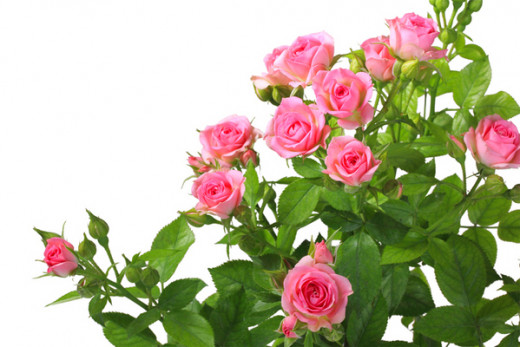How to Grow Roses From Suckers

The title of this article is misleading.
To grow cuttings from rose suckers is a misnomer, for to do so you are taking cuttings from the roots of a grafted plant. Many of the commercially available rose plants are pretty flowers grafted onto vigorous root stocks. It is never recommended to grow cuttings taken from these suckers because grafted roses are grown from hardy roots with the desired flower being grafted onto it. 100% of the time, cuttings taken from suckers are not going to give you flowers that resemble the plant from where they are taken from. On the other hand, if you take cuttings from a rose plant that has not been grafted, you are guaranteed to get an exact clone of the mother plant.
Typically, suckers from grafted roses are removed from where they grow from the plant by digging down and cutting them off at the source to get rid of them. This is because they 'suck' the energy from the plant, which is where they get the name 'sucker'. While it is possible to grow a new plant from these, you will not get a desirable product from doing so. It is best to take cuttings from branches of roses that have not been grafted. With that being said, find instructions following for how to take cuttings from a rose. If you choose to use this method to grow the suckers, then just know that you won't get a beautiful rose bush to admire, but a suckering monster that can take over your entire garden.
Stuff You Need
Gather the following items before you start:
Pruning Shears
Bucket X 2
Pots
Sand
Sphagnum Moss
6-8 inch Pots
Pencil
Paper Towel
Hormone Rooting Powder
Bowl
Metal Bamboo Skewers
Plastic Bags
Step One
In the spring use pruning shears to cut off 8 to 10 inch pieces from the tip of the branches that you would like to use. Pick branches that are healthy and have new growth on them. Take several in case one or two don’t make it. If they all make it and you don’t want to use them all in your garden, you can always give them to neighbors and friends, they’ll love you for it. Put them in a bucket full of tepid water like a bouquet while you perform the next step.
Step Two
Next, get your pots ready by filling them with a sterile potting soil. Mix 2 parts clean sand and 1 part sphagnum moss in a large clean bucket. Fill some 6 or 8-inch pots with the mixture and water them until water is draining out of the bottom. Make sure you pour water over the entire surface so that the soil is evenly moist. Use a pencil to make a hole in the center of the pot about four inches deep.
Step Three
Now take the cuttings out of the water and dry them off on a paper towel. Use the pruning shears to remove the bottom two inches of each branch - make this cut at a 45-degree angle. This will expose as much possible cut surface as possible to absorb water and nutrients.
Step Four
Pour some hormone rooting powder into a small bowl and dip one of the cuttings into the powder and give it a little tap to remove any loose powder. Place one cutting into the hole you made in the pot and press the soil around the branch to set it firmly in place. Make it as straight as possible so you don’t end up with a crooked plant.
Stick two metal bamboo skewers on opposite sides of the pots to the bottom. Place a clear plastic bag over each pot and tuck the open end under the pot. The skewers will keep the plastic from coming into contact with the cuttings, which can cause them to get mouldy.
A Rose by Any Other Name...
Step Five
Place the pots in a bright location but keep them out of direct sunlight. The plastic will help to keep them very moist; to be cautious check on them every day or every other day to make sure that they have enough water. Don’t let them dry out at any time because the roots that are trying to develop can also dry out and shrivel up, which will put all that hard work to waste.
Step Six
Once you see some new growth developing, go ahead and remove the plastic bag and place them in a spot that receives about half a day of direct sun. Water them when the surface soil appears dry. They will be ready to transplant in a permanent location in your garden by late fall.
As stated earlier, do as many as you possibly can to increase the ratio of success because it is never guaranteed that each of the rose cuttings will take. If you end up with more than you want, then give or donate them. After all, who wouldn’t love to receive a living gift?









